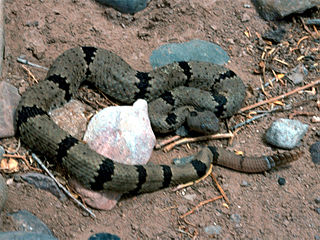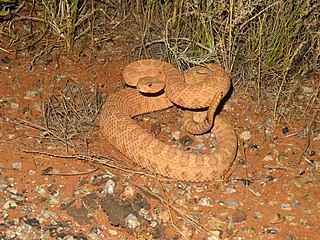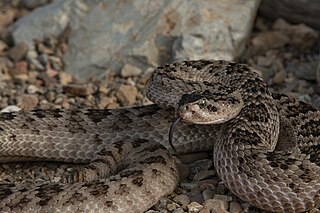
Crotalus scutulatus is known commonly as the Mohave Rattlesnake. Other common English names include Mojave Rattlesnake and, referring specifically to the nominate (northern) subspecies: Northern Mohave Rattlesnake and Mojave Green Rattlesnake, the latter name commonly shortened to the more colloquial “Mojave green”. Campbell and Lamar (2004) supported the English name “Mohave (Mojave) rattlesnake” with some reluctance because so little of the snake’s range lies within the Mojave Desert.

The timber rattlesnake, canebrake rattlesnake, or banded rattlesnake is a species of pit viper endemic to eastern North America. Like all other pit vipers, it is venomous, with a very toxic bite. C. horridus is the only rattlesnake species in most of the populous Northeastern United States and is second only to its relatives to the west, the prairie rattlesnake, as the most northerly distributed venomous snake in North America. No subspecies are currently recognized.

The eastern diamondback rattlesnake is a species of pit viper in the family Viperidae. The species is endemic to the Southeastern United States. It is one of the heaviest venomous snakes in the Americas and the largest rattlesnake. No subspecies are recognized.

Crotalus helleri or Crotalus oreganus helleri, also known commonly as the Southern Pacific rattlesnake, the black diamond rattlesnake, and by several other common names, is a pit viper species or subspecies found in southwestern California and south into Baja California, Mexico, that is known for its regional variety of dangerous venom types. It is sometimes considered a subspecies of Crotalus oreganus.

Crotalus willardi is a venomous pit viper species found in the southwestern United States and Mexico. This snake is found mainly in the "sky island" region. The IUCN reports this snake's conservation status as being of Least Concern. It is the official state reptile of Arizona.

Crotalus ruber is a venomous pit viper species found in southwestern California in the United States and Baja California in Mexico. Three subspecies are currently recognized, including the nominate subspecies described here.

Crotalus viridis is a venomous pit viper species native to the western United States, southwestern Canada, and northern Mexico. Currently, two subspecies are recognized, including the prairie rattlesnake, the nominate subspecies, and the Hopi rattlesnake.

Crotalus mitchellii is a venomous pit viper species in the family Viperidae. The species is endemic to the Southwestern United States and adjacent northern Mexico. The species was named in honor of Silas Weir Mitchell (1829–1914), an American medical doctor who also studied rattlesnake venoms. Five subspecies are currently recognized, including the nominate subspecies described here.

Crotalus enyo, commonly known as the Baja California rattlesnake or Lower California rattlesnake, is a pit viper species native to the coast and islands of northwestern Mexico. Like all other pit vipers, it is venomous. Three subspecies are currently recognized, including the nominate subspecies described here.

Crotalus lepidus klauberi is a venomous pitviper subspecies endemic to the southwestern United States and adjacent northern Mexico.

Crotalus oreganus abyssus is a venomous pit viper subspecies found only in the U.S. states of Arizona and Utah.

Crotalus durissus, known as the South American rattlesnake, tropical rattlesnake, and by other names, is a highly venomous pit viper species found in South America. It is the most widely distributed member of its genus. Currently, seven subspecies are recognized.

Crotalus oreganus, commonly known as the Western rattlesnake or northern Pacific rattlesnake, is a venomous pit viper species found in western North America from the Baja California Peninsula to the southern interior of British Columbia.

Crotalus stejnegeri, commonly known as the Sinaloan long-tailed rattlesnake or just long-tailed rattlesnake, is a venomous pit viper species in the family Viperidae. The species is native to western Mexico. There are no recognized subspecies.

Crotalus concolor, commonly known as the midget faded rattlesnake, faded rattlesnake, and yellow rattlesnake, is a pit viper species found in the western United States. It is a small rattlesnake known for its faded color pattern. Like all other pit vipers, it is venomous.
Crotalus totonacus is a venomous pit viper species found in northeastern Mexico. No subspecies are currently recognized.
Crotalus lepidus maculosus, or the Durangan Rock Rattlesnake is a Mexican subspecies of the Rock Rattlesnake, a venomous species of pit viper.

Crotalus scutulatus salvini, commonly known as the Huamantlan rattlesnake, is a venomous pit viper, currently classified as a subspecies of C. scutulatus that is found in mainland Mexico, at the southern end of the distribution of C. scutulatus. The subspecific epithet honors the nineteenth century British naturalist Osbert Salvin.
Crotalus enyo furvus, also known as the Rosario Rattlesnake or the Dusky Baja California rattlesnake is a subspecies of Baja California rattlesnake, a kind of venomous pit viper. It is named after the latin 'furvus' meaning 'dark complexion' or 'swarthy', referring to the colouration of the subspecies. It is found on the San Quentin Plain in Baja California del Norte - due to the area's restricted and largely inaccessible habitat not much is known about the subspecies.















